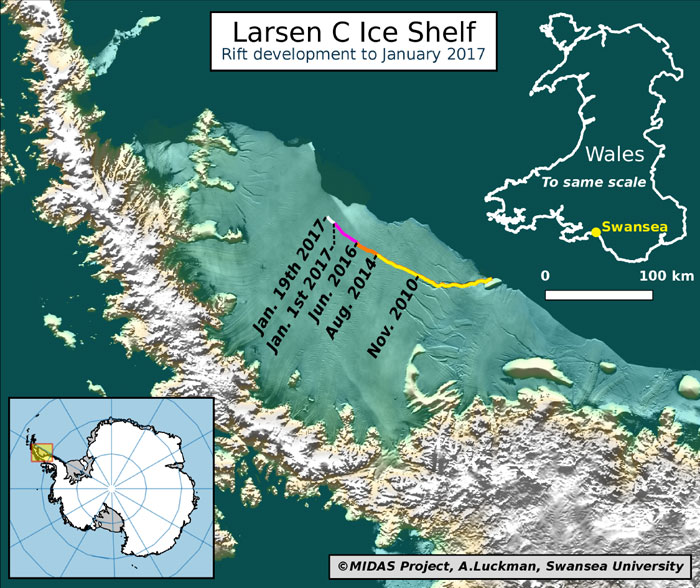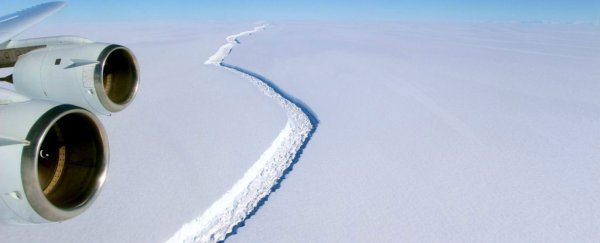A massive iceberg the size of Delaware is now even closer to breaking free from Antarctica, due to a huge, widening crack in the Larsen ice shelf that's not showing any signs of stopping.
Satellite imagery reveals that this gigantic rift now extends for 175 km (108.7 miles), having already gained an extra 10 km (6.2 miles) since January 1. Scientists say it's just a matter of time now before a gigantic iceberg calves from the rest of the shelf – which would make it one of the biggest icebergs in recorded history.
Scientists from UK-based Antarctic research project MIDAS announced the new findings on their website last week.
"My feeling is that this new development suggests something will happen within weeks to months," one of the researchers, Adrian Luckman from Swansea University, told BBC News, "but there is an outside chance that further growth will be slow for longer than that."
 MIDAS
MIDAS
Despite its accelerated pace in recent times, this crack has actually been something of a slow burner, carving its way through Larsen C's ice for decades.
But what began as a small crack in the 1960s sped up dramatically in 2010, and since then, it's effectively doubled in length, and now spans roughly 5,000-square-kilometres (1,930 square miles).
The most rapid development came in December 2016, when a growth spurt saw the rift extend 18 km (11 miles) in just a couple of weeks.
Because the crack is growing in parallel with the shelf edge of Larsen C, if it continues on its current trajectory, there's about 100 kilometres (62.1 miles) of ice left in its path.
But if it were to veer sharply northwards, there's only about 20 kilometres (12.4 miles) of ice connecting this huge mass to the rest of the shelf –which means Larsen C would lose more than 10 percent of its entire area.
Just when that happens is anybody's guess, though.
"The rift tip has just entered a new area of softer ice, which will slow its progress," Luckman told Jonathan Amos at BBC News.
"Although you might expect any extension to hasten the point of calving, it actually remains impossible to predict when it will break because the fracture process is so complex."
If and when the calving occurs, the researchers think it will accelerate the destabilisation of the rest of the Larsen C shelf – which is about 350 metres (1,150 feet) thick, and floats on top of the ocean.
Larsen C is the largest of the three Larsen shelves, and if these shelves become too unstable they can disintegrate – which is what happened to the majority of Larsen B after a similar rift-induced calving event in 2002. Larsen A suffered a similar fate in 1995.
"The calving of this large iceberg could be the first step of the collapse of Larsen C ice shelf, which would result in the disintegration of a huge area of ice into a number of icebergs and smaller fragments," said glaciologist David Vaughan from the British Antarctic Survey in a press release earlier in the month.
"Because of the uncertainty surrounding the stability of the Larsen C ice shelf, we chose not to camp on the ice this season."
While losing Larsen C would create one of the biggest icebergs the world has ever seen, the more worrying ramifications are what that would mean for the Antarctic ice sheet – which the Larsen shelf currently buffers from the sea.
When ice shelves break off from the continent to which they're attached, it can speed up the flow of glaciers on the Antarctic ice sheet into the ocean – which can cause sea levels to rise.
In the case of Larsen C disintegrating, it's been estimated that this effect could cause sea levels to rise by around 10 centimetres (3.9 inches).
Which is why all eyes are trained on the growing rift on Larsen C, to see just how it develops from here, and what happens next, after the inevitable calving takes place.
"Even a little sea-level rise can matter to coastal people already on the edge," glaciologist Richard Alley from Penn State University explained to The Washington Post in 2015.
"[U]nderstanding this will help in understanding the larger, more globally important events that remain possible in our future."
